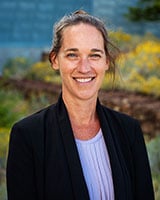Lisa Morey – Compressed Earth Blocks
Lisa Morey of Colorado Earth LLC is using sustainably produced thermal mass masonry blocks (EcoBlox) to diversify the use of cement-based products with a low embodied-carbon, fireproof material.
About
Lisa Morey
Morey owns and operates Nova Terra, which expands the use of locally produced building materials by creating micro-manufacturing sites for compressed earth blocks, a low-carbon masonry unit that minimizes the world's need for cement.
During West Gate, Morey will test the integration of phase-change materials to enhance the operational performance of the blocks, especially in colder climates.

In the News
'I Said to Myself, Dirt Doesn't Burn': The People Rebuilding Their Homes With Earth, BBC
Oct. 22, 2024
Unfired Earth Blocks Surpass Modern Building Codes, Voice of America
July 9, 2024
OEDIT Announces Grants to 42 Colorado Startups and Researchers in the Advanced Industries, Colorado Office of Economic Development and International Trade
May 16, 2024
Critical Need
With population growth projections calling for extensive housing and construction needs over the next several decades, it's critical to reduce operational energy and the embodied carbon emissions from making materials and assembling them in buildings. This will require moving away from current materials such as Portland cement, which emits a ton or more of carbon for each ton produced, accounting for about 8% of all anthropogenic global emissions.
Potential Impact
Nova Terra's nature-based solution for the building envelope integrates an ancient building material with recently used phase-change materials (PCMs). The work is based on the need to develop an energy-efficient building approach that requires no highly insulated assemblies.
By incorporating locally manufactured EcoBlox and PCMs into buildings, the thermal mass of the blocks and PCM will absorb and release thermal energy more efficiently, helping to regulate temperature, reduce energy consumption, and shift the time when the peak load occurs. This results in less heating, ventilating, and air conditioning equipment, all with a low-embodied carbon footprint.
Innovation and Advantages
Unlike traditional insulation, EcoBlox and PCMs do not resist heat flow and control temperature for a time. The amount of time depends on the delta between the spaces, the conductivity of the heat-flow path, and the amount of PCM and thermal mass used. Applying these materials can reduce the need for high-embodied carbon insulation, concrete, and timber frame wall assemblies, which ensures resistance to fire and other extreme weather events.
Profile
Status
Commercially ready
Industry
Buildings, energy efficiency, and life cycle assessment
Potential Markets
- Policymakers to incentivize operational and embodied energy efficiency
- Insurance carriers interested in fire-resistant structures
- Building professionals seeking solutions to reduce carbon emissions
Looking For
- Industry mentors
- Funding
- Strategic partnerships
- Customer identification
- Subject matter experts
Share
Last Updated July 23, 2025
